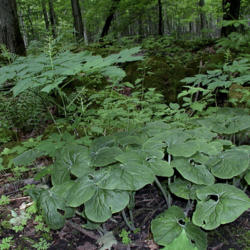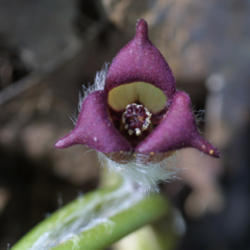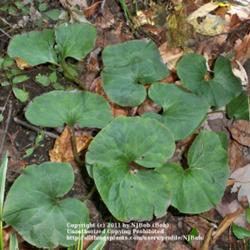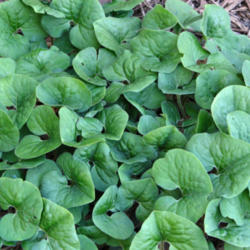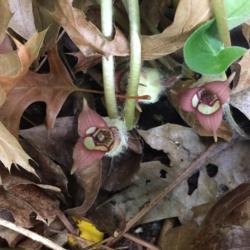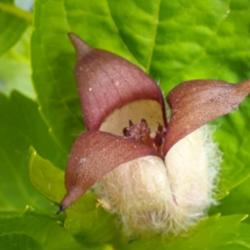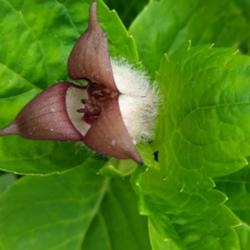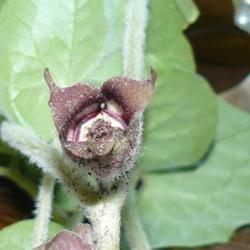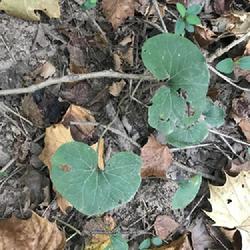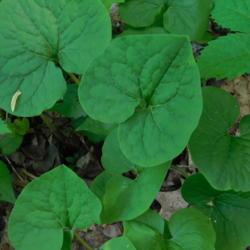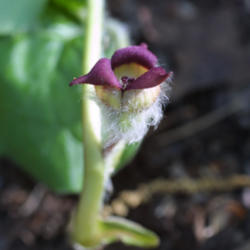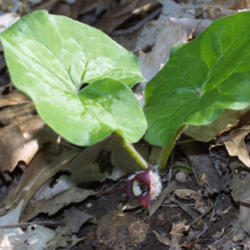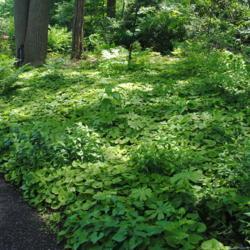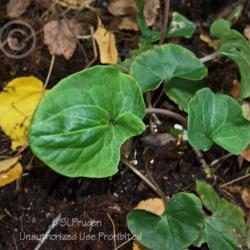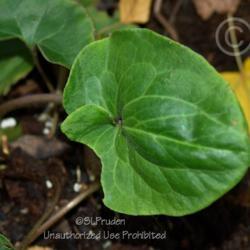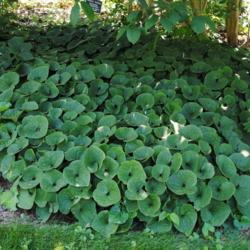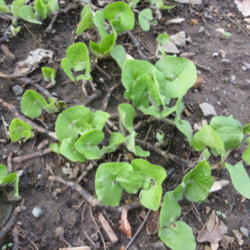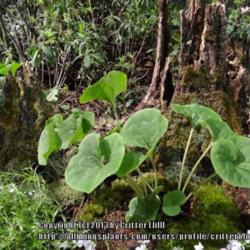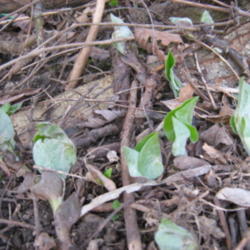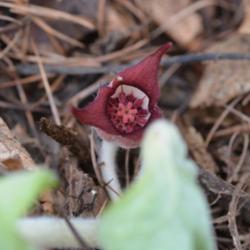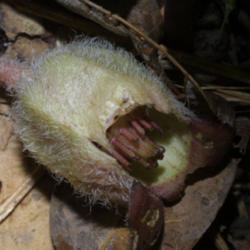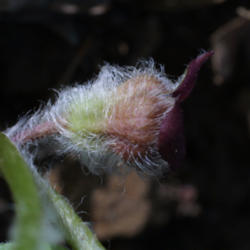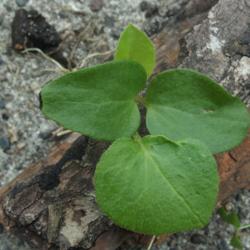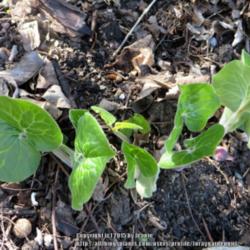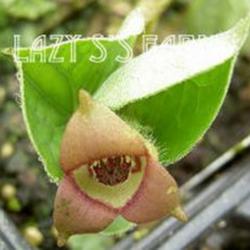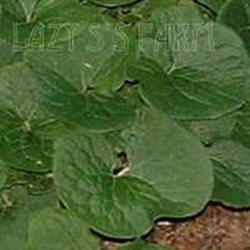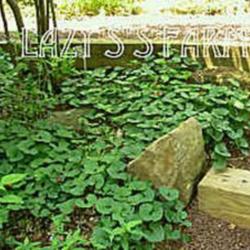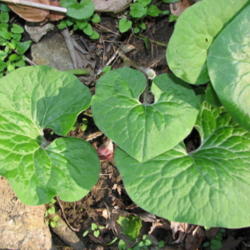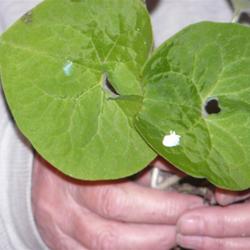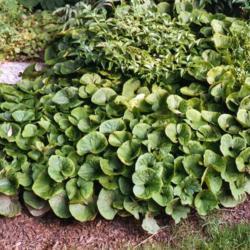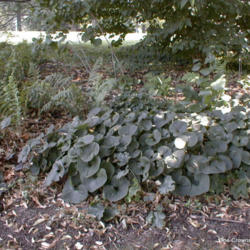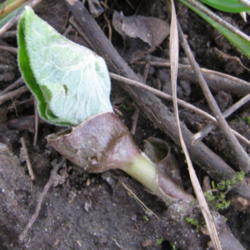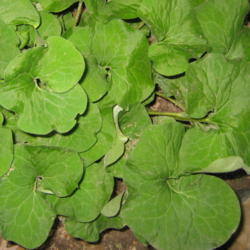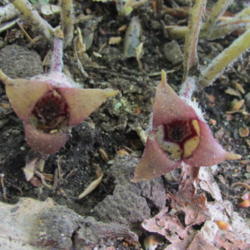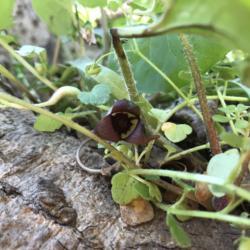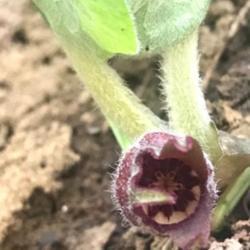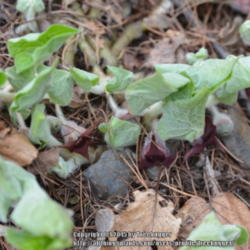Posted by
jmorth (central Illinois) on Dec 11, 2011 5:26 PM concerning plant:
The 1 inch (across) flower lacks petals. It has 3 pointed sepals that curve backwards.
Wild ginger likes moist woods, where it is likely to form dense, sometimes huge colonies.
Settlers used the root as a spice substitute for tropical ginger. It was used in frontier medicine to treat various ailments. The Mesquakie Indians used it extensively as a seasoning. They also thought its use when eating an animal that had died of unknown causes eliminated the danger of poisoning.
Posted by
Catmint20906 (PNW WA half hour south of Olympia - Zone 8a) on Aug 22, 2014 7:03 PM concerning plant:
Ginger Root (Asarum canadense) is a larval host plant for the Pipevine Swallowtail Butterfly. Native to eastern North America, it puts out purple blooms in early to mid spring, and prefers medium to moist soil in part to full shade. It spreads slowly by rhizomes to create an attractive ground cover in shady areas.
Native Americans used A. canadense's rhizomes as a medicinal herb and a seasoning, but although the smell is similar to ginger (Zingiber officinale), it should not be used as a substitute due to carcinogenic concerns. Its aromatic distillate, Canadian snakeroot oil, has been used as a fragrance in oils, salves, and potpourri mixes.
Posted by
sallyg (central Maryland - Zone 7b) on Aug 5, 2019 8:09 AM concerning plant:
I've had this for years. It makes a mat/clump and It has slowly expanded with zero care except watering when very dry periods make it wilt. Very resilient, I have it in shade with tree root competition. Nice unusual foliage look. Caution, chicken foraging will damage it over winter. Rocks and twig barriers (stick small branches in the ground throughout) will help shelter the roots.
Posted by
SongofJoy (Clarksville, TN - Zone 6b) on Jan 15, 2012 4:40 PM concerning plant:
There are just under a dozen species of wild gingers, or Little Brown Jugs, which are native to the eastern United States. They grow in rich organic soil shaded by tall trees and shrubs. The evergreen species are in the genus Hexastylis, and the only non-evergreen one is Asarum. All have interesting brown, jug-shaped flowers that are attached at soil level. The leaves of Deciduous Wild Ginger are bright green, heart-shaped, slightly fuzzy, and large (up to 6 inches across), and it is the only native ginger that loses its leaves in the winter. However, it is also the fastest spreader and makes a great groundcover in good soil in the shade. It grows to about 6 inches tall.
Posted by
KFredenburg (Black Hills, SD - Zone 5a) on Jun 6, 2020 2:22 PM concerning plant:
Low-growing mat-forming plant with inconspicuous spring flowers almost hidden by flossy foliage.
For propagating by division:
Plant the new sections no deeper than 1 inch and space them 8 to 12 inches apart.
Landscape uses:
Wild ginger makes an attractive ground cover that spreads by creeping roots. Plant it in a woodland garden beneath shrugs or in a shaded wildflower garden, or use it as an edging plant.
Posted by
ILPARW (southeast Pennsylvania - Zone 6b) on Mar 17, 2018 9:28 AM concerning plant:
This Canadian Wild-Ginger is an easy, somewhat slow growing groundcover plant. I have seen some growing wild in rich, moist soils of the woods of southeast Pennsylvania. Its native range is from New Brunswick through southern Quebec & Ontario into southern Manitoba down into Oklahoma to northern Louisiana to Georgia, growing in various wooded situations. Its best pH range is 6 to 7, but can go over and under some. It is called Wild-Ginger because the rhizome roots emit a ginger-like odor and they can be cooked to have a ginger substitute, though it is warned that the foliage is toxic and it would not be good to eat much of the roots that have some toxic also. It is a larval host for the Pipeline Swallowtail Butterfly. It is in the Pipeline Family and not a true Ginger. Prairie Nursery in central Wisconsin notes that it is a good groundcover plant to overcome the invasive European Garlic-Mustard and that it can suppress evil Buckthorn seedlings and other invasive plants. Plant about a foot apart to form a solid groundcover. This species is sold by most native plant nurseries and by a good number of conventional nurseries with a diverse selection of perennials. I see it occasionally in gardens and landscapes.
Posted by
Chillybean (Iowa - Zone 5a) on Aug 12, 2015 3:50 PM concerning plant:
I planted some of this in a shaded area next to the house, spring of 2014. The dormant roots grew and even flowered that first year. This year, I seemed to have lost some and I never found any flowers. A friend told me to just give it time, and I may end up with too many.
I enjoy native plants, but this is a special one. You have to get down low to find the unusual blossoms. I like the family name of this plant, Birthwort. This might come from the fact that the juice from the stem was used long ago for inducing childbirth.
